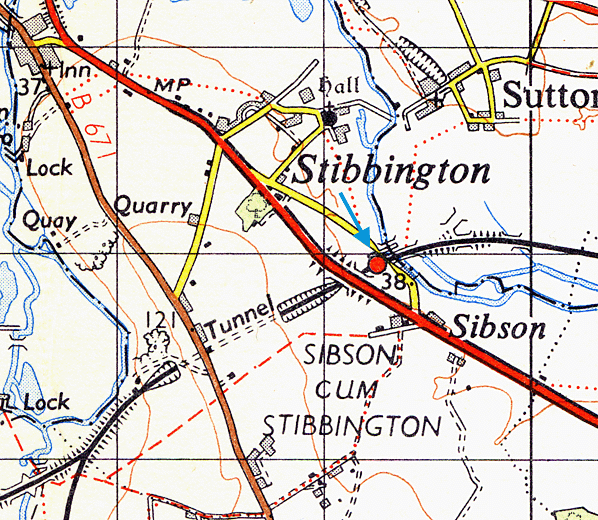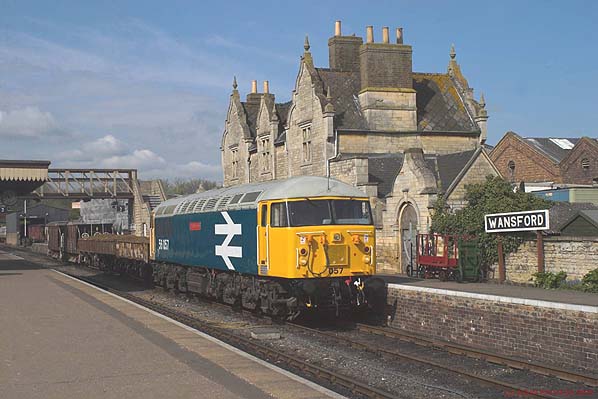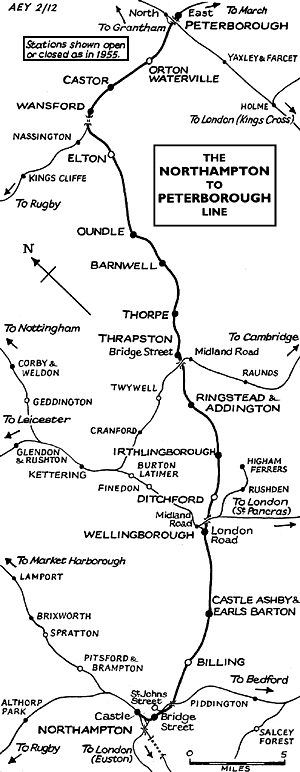
Station Name: WANSFORD
|
| Date opened: | 2.6.1845 |
| Location: | North side of Station Road (A427) |
| Company on opening: | London & Birmingham Railway |
| Date closed to passengers: | 1.7.1957 - reopened by Nene Valley Railway 1.6.1977 |
| Date closed completely: | 13.7.1964 - reopened by Nene Valley Railway 1.6.1977 |
| Company on closing: | British Railways (London Midland Region) |
| Present state: | The station has been rerstored as the headquarters of the Nene Valley Railway. The original main station building is currently unused and in need of repair. A new down platform has been built and the station building from Barnwell moved to it. |
| County: | Northamptonshire |
| OS Grid Ref: | TL046890 |
| Date of visit: | 1995 & 3.6.2006 |
|
Notes: Wansford Station was shown as Wansford Sibson some early timetables. Adter closure to passengers in 1957 the station remained open for freight traffic until 13.7.1964. The up platform was shortened during this period. The station was reopened in 1977 as the headquarters of the
Nene Valley
Railway. The two platforms were originally staggered but
a new down platform has been built opposite the up platform
and the main station building from Barnwell
was moved here on 5th April 1977.
During the first half of the 20th century the line formed an important connection from Norwich, Cambridge and eastern England to Northampton and the Midlands. The line was generally acknowledged to be a secondary mainline and regularly saw heavy through traffic but operating costs were high with a large number of manned level crossings. With the closure of many of the mines and the popularity of the car both passenger and freight traffic was in decline after WW2 and in July 1963 the withdrawal of passenger service between Northampton Castle and Peterborough East was announced. Despite a vigorous campaign against closure culminating in a public meeting at Thrapston, little could be done. A petition was started and action committee appointed but when the committee asked for a collection to meet their expenses only £1 18s 3d was raised! The line was formally closed on Monday 4 May 1964. Iron Ore trains continued to use the line until 1966 with through freight traffic finally being withdrawn by British Rail in 1972. In 1974 the Peterborough Development Corporation bought a section of the Nene Valley line between Longville and Yarwell Junctions and leased it to the Peterborough Railway Society to operate the railway. Between 1974 and May 1977 the line was upgraded to passenger standards and on 24 May the Railway Inspector passed the railway as fit for passenger carrying operations and the Nene Valley Railway between Wansford and Orton Mere was officially opened on 1 June 1977. In 1986 the line was eastwards to a new terminus at Peterborough Nene Valley just short of the East Coast Main Line making a total running length of 7.5 miles and a new station is currently under construction at Yarwell Junction at the western end of the line. There are also proposals for a link with the ECML which would allow trains to run into Peterborough Station. Route map drawn by Alan Young. See also: Nene
Valley Railway web site To see other stations on the Nene Valley Railway click on the station name: Northampton Bridge Street, Billing, Castle Ashby & Earls Barton, Wellingborough London Road, Ditchford, Irthlingborough, Ringstead & Addington, Thorpe, Barnwell, Oundle, Elton, Castor, Orton Waterville, Peterborough Nene Valley & Peterborough East |
old1.jpg) Wansford Station
looking east before 1910
Wansford Station
looking east before 1910Copyright photo from John Alsop collection

7.jpg) Wansford Station
looking west in September 1967. Note the platform has been shortened.
Wansford Station
looking west in September 1967. Note the platform has been shortened.Copyright photo by John Alsop

EMRPS Charter at Wansford Station looking west on the 28th April 2006. Note the platform has been restored to its original length.
Photo by John Patson from John Patson's Railway Photographs web site

|
 Home
Page
Home
Page
| Last updated: Friday, 26-May-2017 09:53:58 CEST |
© 1998-2008 Disused Stations
|

old_thumb2.jpg)


thumb6.jpg)
_thumb7.jpg)
thumb7.jpg)
thumb9.jpg)
_thumb5.jpg)
_thumb6.jpg)


_thumb3.jpg)

